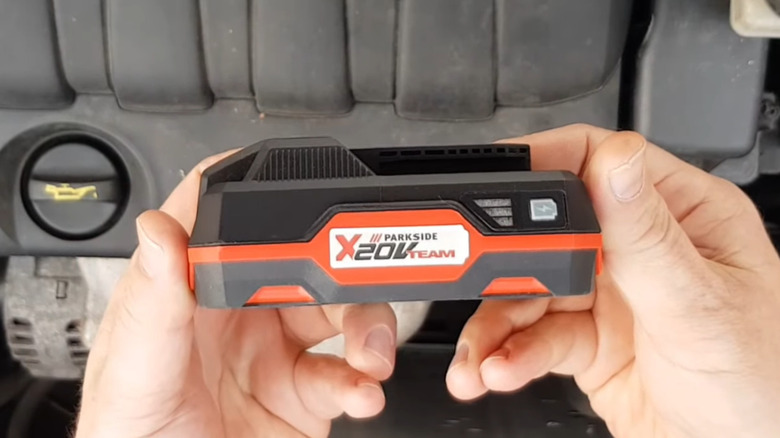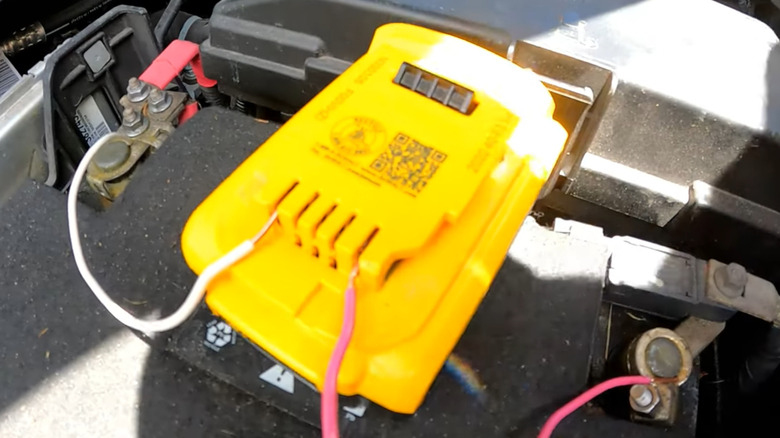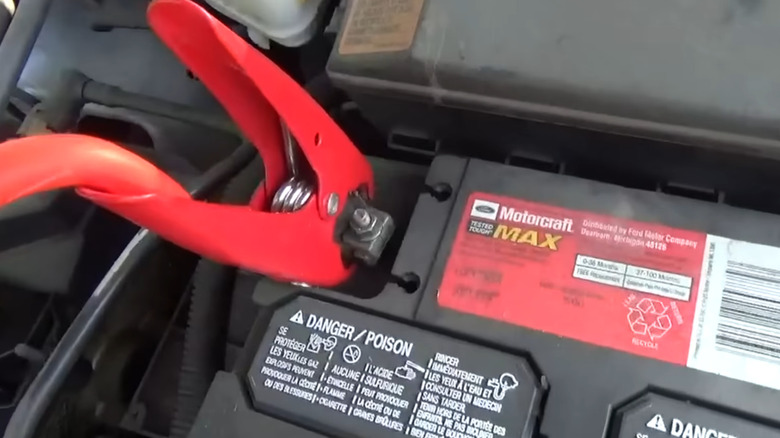Here's Why You Shouldn't Jump A Car With A Power Tool Battery
There are a ton of clever hacks on social media today, and to be honest, a good number of them can help you save money and even get out of a tricky situation. For instance, grabbing the nearest 18V battery like those used on Ryobi or Milwaukee tools and hooking it up to your dead car battery might seem like a plausible idea. After all, there are hundreds of videos online of people doing it with positive results, right?
What seems like a shortcut or quick fix is actually one of the fastest ways to brick your vehicle's electronics, damage your power tool battery, and possibly start a fire. Modern car electronics feature sensitive modules that have been designed to run on a 12-volt supply, and zapping them with an extra six or eight volts is like lighting a fireplace with a flamethrower. It might work immediately, but you risk burning down your house (power tools have recessed contacts; a tiny error could cause a short circuit and lead to a small fire).
Why Jumping a car with a power tool battery is not a clever hack
Jumping your car with anything other than a jumper starter pack is generally not recommended since modern cars feature sensitive electronics that could get damaged with the extra voltage bump, leading to expensive repairs. For starters, lithium-ion batteries used on power tools are designed for steady use or low intermittent use. Car batteries, on the other hand, need a high, consistent current since a starter motor draws between 200 and 600 amps in milliseconds. As such, hooking a power tool to your car battery can lead to overheating or thermal runaway.
Car batteries have a 12V output designed for an automotive system, while power tool batteries typically have between 18V and 20V (can spike higher when fully charged). Exposing your vehicle to extra voltage can overload and damage your car's ECU, sensors, and even the infotainment system. Lithium-ion packs found in power tools feature internal protection circuits designed for their individual loads. Using it to jumpstart your car battery bypasses this safety net, and when pushed too hard, it could swell, vent, or worse, catch fire. Lithium-ion fires are a huge safety concern.
Modern cars that feature start/stop technology are more vulnerable to damage not only by power tool batteries but also to improper jumpstarting procedures. Start/stop systems use specialized batteries specially designed for starts and stops. Improper jump-starting can damage their batteries and associated systems.
Alternative solutions to jump starting a dead car battery
If you are reaching for a power tool to charge your dead car battery, nine out of ten times, you are in the comfort of your home or workshop. And while calling AAA might be a last resort, it's often the safest move, especially if you are stuck by the roadside. One wrong move with a DIY setup can short-circuit your vehicle's electronics, leaving you with repair bills that are far higher than the cost of a proper jump starter pack.
It is recommended to use a proper jump starter to boost your car battery. These portable gadgets are designed with the correct voltage and power output for jump-starting dead batteries and include safety features to prevent damaging your car's electronics. If you have access to another vehicle, you can go old-school and boost your dead battery with jumper cables.
If you have a modern car and are unsure of the correct way of jump-starting a dead battery, your safest bet is to consult a mechanic or roadside assistance service. Remember, improper jump starting can damage your vehicle's electronics and, in some cases, lead to a serious fire hazard.


